Jared Wareham: Are Balanced Trait Genetics a Long-Term Answer?

Genetic progress has helped drive our industry forward and each segment along the value chain has
benefited from technological advancements in genetics followed by breeder integration. But, have we moved the needle far enough with regard to total beef system profitability?
There are opportunities to take a step forward from the current “one size fits all” production models. Managers are seeking solutions to their constant struggle to balance getting cows bred while producing highly desirable feeder cattle. Any direction a manager leans, maternal or terminal, tends to leave them in a profitability-strapped state. Have balanced trait idealisms taken us as far as they can? Is it time to consider terminal breeding systems?
Frankly, average cow productivity simply isn’t good enough to sustain profitability in most systems long-term. There is a real need for advancements in maternal productivity. Highly functional cows that last longer are simply hard to make while also trying to blend the genetics required for terminal performance.
If we truly believe in sustainable production moving forward, this must be accounted for in the environmental equation that supports progress in all areas. Therefore, is it time to examine the feasibility of focused maternal genetic inputs matched with a terminal genetic line to maximize heterosis and metric specific performance traits?
Moreover, why continue to fight the genetic balancing battle while simultaneously struggling with regional environmental challenges and other competing profit centers? If a tiger stripe is the Cadillac of your area, cultivate internal or external pipelines that will meet annual replacement rates. After that, simply use targeted terminal crosses to maximize value-based marketability. The same can be said for every region from coast to coast.
If large ranching systems coast to coast begin this transition into more defined approaches to production with clear efforts toward highly simplified maternal and terminal genetic lines, is that a step backward? Or, does it represent true progress in system processes that will ultimately drive successful ranching? I think it might be the next logical step. A transition made possible by technologies such as sexed semen and other advancements in genetics and forced by growing challenges to operational efficiencies.
It might represent a form of production that is simply a generation newer. Perhaps the time has come to finally effectively utilize purpose specific lines of genetics to achieve sustainable levels of profit through the right combination of simplicity and precision. Balanced trait genetic approaches have brought the national beef herd to the great place it is today. However, will its overarching effectiveness continue to diminish as our industry progresses?
Jared Wareham is the North American business development manager for ABS NuEra. He has been involved in the cattle industry for over two decades, in business development roles growing genetics-focused companies that service producers along the beef value chain by driving the integration of precision-based production.







